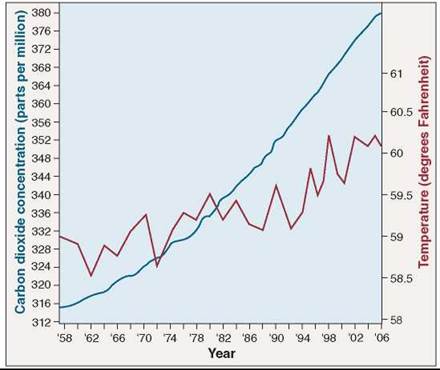THE LIVING WORLD
Unit Eight. The Living Environment
38. Human Influences on the Living World
For over 150 years, the growth of our industrial society has been fueled by cheap energy, much of it obtained by burning fossil fuels—coal, oil, and gas. Coal, oil, and gas are the remains of ancient plants, transformed by pressure and time into carbon-rich “fossil fuels.” When such fossil fuels are burned, this carbon is combined with oxygen atoms, producing carbon dioxide (CO2). Industrial society’s burning of fossil fuels has released huge amounts of carbon dioxide into the atmosphere. No one paid any attention to this because the carbon dioxide was thought to be harmless and because the atmosphere was thought to be a limitless reservoir, able to absorb and disperse any amount. It turns out neither assumption is true, and in recent decades, the levels of carbon dioxide in the atmosphere have risen sharply and are continuing to rise.
What is alarming is that the carbon dioxide doesn’t just sit in the air doing nothing. The chemical bonds in carbon dioxide molecules transmit radiant energy from the sun but trap the longer wavelengths of infrared light, or heat, that are reflected off the earth’s surface and prevent them from radiating back into space. This creates what is known as the greenhouse effect. Planets that lack this type of “trapping” atmosphere are much colder than those that possess one. If the earth did not have a “trapping” atmosphere, the average earth temperature would be about -20°C, instead of the actual +15°C.
Global Warming Due to Greenhouse Gases
The rise in average global temperatures during recent decades, a profound change in the earth’s atmosphere referred to as global warming (shown as the red line in figure 38.4), is correlated with increased carbon dioxide concentrations in the atmosphere (the blue line). The suggestion that global warming might in fact be caused by the accumulation of greenhouse gases (carbon dioxide, CFCs, nitrogen oxides, and methane) in the atmosphere has been controversial, and is examined in detail in the Inquiry & Analysis feature at the end of this chapter. After serious examination of the evidence, the overwhelming consensus among scientists is that indeed greenhouse gases are causing global warming.

Figure 38.4. The greenhouse effect.
The concentration of carbon dioxide in the atmosphere has shown a steady increase for many years (blue line). The red line shows the average global temperature for the same period of time. Note the general increase in temperature since the 1950s and, specifically, the sharp rise beginning in the 1980s. Data from the National Center for Atmospheric Research and other sources.
Increases in the amounts of greenhouse gases increase average global temperatures from 1° to 4°C, which could have serious impact on rain patterns, prime agricultural lands, and changes in sea levels.
Effects on Rain Patterns. Global warming is predicted to have a major effect on rainfall patterns. Areas that have already been experiencing droughts may see even less rain, contributing to even greater water shortages. Recent increases in the frequency of El Nino events (see chapter 36) and catastrophic hurricanes may indicate that climatic changes due to global warming are already beginning to occur.
Effects on Agriculture. Both positive and negative effects of global warming on agriculture are predicted. Warmer temperatures and increased levels of carbon dioxide in the atmosphere would be expected to increase the yields of some crops but have a negative impact on others. Droughts that may result from global warming will also negatively affect crops. Plants in the tropics are growing at near their maximal temperature limits; any further increases in temperature will probably begin to have a negative impact on agricultural yields of tropical farms.
Rising Sea Levels. Much of the water on earth is locked into ice in glaciers and polar ice caps. As global temperatures increase, these large stores of ice have begun to melt. Most of the water from the melted glaciers ends up in the oceans, causing water levels to rise (but because the Arctic ice cap floats, its melting will not raise sea levels, any more than melting ice raises the level of water in a glass). Higher water levels can be expected to cause increased flooding of low-lying lands.
There is considerable disagreement among governments about what ought to be done about global warming. The Clean Air Act of 1990 and the Kyoto Treaty have established goals for reducing the emission of greenhouse gases. Countries across the globe are making progress toward reducing emissions, but much more needs to be done.
Key Learning Outcome 38.3. Humanity's burning of fossil fuels has greatly increased atmospheric levels of CO2 leading to global warming.